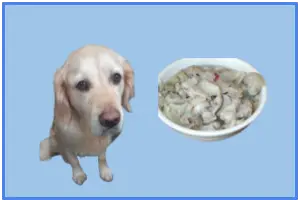
Are you thinking of feeding chicken gizzards to your dog?
You may have heard about this strange organ in a chicken and about how nutritious it is.
But can dogs eat chicken gizzards? Dogs can eat chicken gizzards. Although they are small in size they contain very high levels of minerals and B vitamins and could be considered a superfood. Although there are concerns about feeding them raw to your dog, you can play it safe by cooking them instead. The fact that they do contain some much nutrition means that you should feed them sparingly to your dog. They are quite difficult to get hold of- your local butcher could be your best bet.
What are chicken gizzards?
A gizzard is part of the stomach of a chicken.
Specifically, it is the part of the stomach that grinds up the food.
In humans that job is done by the teeth but of course chickens don’t have any of those.
When I think of gizzards, I think of a slower version of a blender grinding up food to make it easier to digest.
Have I painted a clear enough picture in your head?
Gizzards are often included in a pack of giblets which are included in some store bought whole chickens.
Giblets are a collection of chicken or turkey organs- heart, gizzard, neck, liver and kidneys which many people use to make gravy.
How nutritious are chicken gizzards?
The sentiment of not wasting any part of a slaughtered animal is all well and good but can something which sounds as gruesome as a gizzard have any nutritional value?
You’d be surprised…
After all, chicken livers are a nutrient powerhouse!
I have created a chart below which shows the most relevant nutrition data about gizzards.
To try and place it in context, I have also added the nutrition details of a chicken heart because it’s another organ.
And the values for chicken breast because everyone is familiar with a chicken breast.
All values are for a 100 g serving.
| 100 g | Gizzard | Heart | Breast |
| Calories | 94 | 153 | 220 |
| Fat | 2.1 % | 10 % | 7 % |
| Cholesterol | 240 mg | 136 mg | 135 mg |
| Sodium | 69 mg | 74 mg | 730 mg |
| Carbohydrate | 0 g | 0.7 | |
| Protein | 18 % | 16 % | 40 % |
A gizzard has fewer calories than either chicken heart or breast.
And such a low fat content: it’s almost unbelievable.
Cholesterol is a bit high and protein is higher than heart but much lower than breast.
But, there’s more to nutrition than just fat and protein.
Particularly with organ meats.
Below is another chart with the same three parts of chicken showing what vitamins and minerals they are most rich in.
The broad role of B vitamins is to help with processes like metabolism.
The gizzard is bottom of the pile as far as B3 is concerned and in the middle when it comes to B12.
Copper has a similar role to iron in the body in that one of its main tasks is to help create and maintain red blood cells.
Although a gizzard doesn’t contain as much copper as a heart, it has several times more than chicken breast.
Selenium is a mineral that few people have heard of and once again a gizzard is sandwiched between a heart and a breast.
But on this occasion the breast contains the most.
But what does it do?
Well, it helps keep the thyroid healthy.
And we finish with zinc which supports a healthy immune system amongst other things.
| 100 g | Gizzard | Heart | Breast |
| Vitamin B3 | 3.68 mg | 4.8 mg | 11.0 mg |
| Vitamin B12 | 1.21 mcg | 7.3 mcg | 0.22 mcg |
| Copper | 0.12 mg | 0.35 mg | 0.06 mg |
| Selenium | 25.5 mcg | 4.3 mcg | 33.48 mg |
| Zinc | 2.72 mg | 6.59 mg | 1.13 mg |
Are chicken gizzards value for money?
Comparing the nutrition of a gizzard to other parts of a chicken is one thing but how much do gizzards cost and how available are they?
Well, after checking a few grocery stores in the US I have discovered that it is very hard to get hold of chicken gizzards.
In fact, two grocery stores had a pack of mixed gizzards and hearts in stock (Kroger and Walmart) but the difference in prices was huge.
At Kroger you can buy a 1 lb pack of gizzards and hearts for $1.99, whereas at Walmart a 3 lb pack of gizzards and hearts will cost over $15!
I also found it extremely hard to find any US based online raw food suppliers that stocked any gizzards.
It’s not going too well is it?
It seems to me that you might be better contacting your local butchers and seeing if they stock it or could easily get some for you.
How much gizzard should I give to my dog?
If you do manage to get your hands on some gizzard it would be easy to get a little giddy over all that powerful nutrition and think of feeding it to your dog everyday.
That would be a mistake.
Because a gizzard has such high concentrations of certain vitamins and minerals you should think of feeding these to your dog occasionally.
Although each one only weighs about 30 g and is a few centimeters in diameter (somewhere between the size of a golf and tennis ball), I would give my golden retrievers about one per week.
Although it is very unlikely that your dog could overdose on B vitamins by eating too many gizzards in a short space of time, it is likely that such a rich food would play havoc with their digestion and give them an upset stomach.
Can my dog eat raw gizzard?
Your dog can eat raw gizzard but there are risks involved with feeding any raw meat to your dog, especially raw chicken.
Raw chicken might be infected with the salmonella or campylobacter bacteria.
There is a minimal risk that your dog would become ill as a result of eating food infected with this bacteria.
This bacteria is far more dangerous to humans than dogs.
And by handling raw chicken parts, the chances of you becoming infected and seriously ill increase.
How should I cook gizzard?
Did you know that in some parts of Africa and some parts of Asia, chicken gizzards are considered a delicacy?
And so there are lots of really tasty recipes online for you to be distracted by.
If you are preparing gizzards for your dog, just put them in a pan of boiling water and let them cook for about 15 minutes.
You will know when they are ready because when you slice into them, none of the meat is pink, it is all nicely browned.
Photo credits
¹ Photo by stu_spivack




